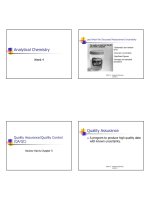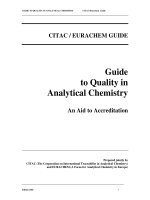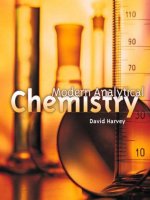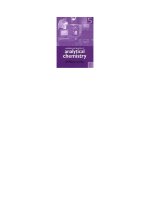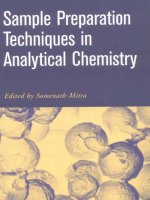Analytical chemistry
Bạn đang xem bản rút gọn của tài liệu. Xem và tải ngay bản đầy đủ của tài liệu tại đây (198.56 KB, 17 trang )
<span class='text_page_counter'>(1)</span>HO CHI MINH UNIVERSITY INDUSTRY ---- CHEMISTRY INDUSTRY --------------. TOPPIC: Analytical chemistry •TEACHER: Ms.Tran Nguyen An Sa •STUDENT: Le Van Tuoi •MSSV. : 11318851..
<span class='text_page_counter'>(2)</span> Introduction to menu 1. Idioms and vocabulary 2. Review grammar 3. What is the analytical chemistry? 4. Exercise.
<span class='text_page_counter'>(3)</span> 1. Idioms ( word formation ): . Analytical chemistry: hóa học phân tích. Analytical chemistry is the study of the separation, identification, and quantification of the chemical components of natural and artificial materials Qualitative analysis: phân tích định tính . Quantitative analysis: phân tích định lượng . Qualitative analysis gives an indication of the identity of the chemical species in the sample and quantitative analysis determines the amount of one or more of these components..
<span class='text_page_counter'>(4)</span> 1. Idioms ( word formation ): . Classical methods : phương pháp cổ điển. Classical methods (also known as wet chemistry methods) use separations such as precipitation, extraction, and distillation and qualitative analysis by color, odor, or melting point. Quantitative analysis is achieved by measurement of weight or volume. . Instrumental methods: phương pháp công cụ . Instrumental methods use an apparatus to measure physical quantities of the analyte such as light absorption, fluorescence, or conductivity. The separation of materials is accomplished using chromatography or electrophoresis methods..
<span class='text_page_counter'>(5)</span> 1. Vocabulary: - Functional group: nhóm chức. - Refractive indexes: chỉ số khúc xạ hay chỉ số chiết suất. - Classical: cổ điển. - Extraction: chiết. - Distillation: chưng cất. - Gravimetric: phân tích trọng lượng. - Titrimetric: phép chuẩn độ. - Chromatographic: sắc ký. - Parallel: tương đương với. - Term: giới hạn. - Statistical: thống kê - Bulk sample: mẫu gộp.
<span class='text_page_counter'>(6)</span> 2. Grammar review: - Adverb clause of condition: second conditional would If + Subject + Simple past tense… + could + Verb in simple form. might. - Example: If you took sample in a same manner, you would obtain the sample results. If we caught the early train, we would get there by lunch. If I had time now, I would write to my friend..
<span class='text_page_counter'>(7)</span> 3. What is the analytical chemistry? Analytical chemistry has been important since the early days of chemistry, providing methods for determining which elements and chemicals are present in the object in question. The first instrumental analysis was flame emissive spectrometry developed by Robert Bunsen and Gustav Kirchhoff who discovered rubidium (Rb) and caesium (Cs) in 1860. Gustav Kirchhoff (left) and Robert Bunsen (right).
<span class='text_page_counter'>(8)</span> Classical methods (also known as wet chemistry methods) use separations such as precipitation, extraction, and distillation and qualitative analysis by color, odor, or melting point. Quantitative analysis is achieved by measurement of weight or volume. Flame test: Inorganic qualitative analysis generally refers to a systematic scheme to confirm the presence of certain, usually aqueous, ions or elements by performing a series of reactions that eliminate ranges of possibilities and then confirms suspected ions with a confirming test. The presence of copper in this qualitative analysis is indicated by the bluish-green color of the flame..
<span class='text_page_counter'>(9)</span> Instrumental methods use an apparatus to measure physical quantities of the analyte such as light absorption, fluorescence, or conductivity. The separation of materials is accomplished using chromatography or electrophoresis methods. Spectroscopy: Spectroscopy measures the interaction of the molecules with electromagnetic radiation.. Block diagram of an analytical instrument showing the stimulus and measurement of response.
<span class='text_page_counter'>(10)</span> Separation: Separation processes are used to decrease the complexity of material mixtures. Chromatography and electrophoresis are representative of this field.. Separation of black ink on a thin layer chromatography plate..
<span class='text_page_counter'>(11)</span> Microscopy: The visualization of single molecules, single cells, biological tissues and nanomaterials is an important and attractive approach in analytical science.. Fluorescence microscope image of two mouse cell nuclei in prophase (scale bar is 5 µm)..
<span class='text_page_counter'>(12)</span> 4. Exercise A.Completing sentences: 1. A qualitative method yields information about the identity of atomic or molecular species or the functional ……………………………………………………………..…… groups that exist in the sample . quantitative 2. ………………….. method provides numerical information as to the relative amount of one or more of these components. 3. For quantitative analyses, the amount of analyte was determined gravimetric or by ……………… titrimetric measurement. by …………….. 4. In titrimetric procedure, the volume ……… or weight of standard reagent required to react completely with the analyte was measured. 5. Samples with a low …………………. of analyte may need to be concentration concentrated prior to analysis..
<span class='text_page_counter'>(13)</span> 4. Exercise A.Completing sentences: methods for determining 6. Analytical - Chemistry deals with …………… the chemical composition of samples of matter laboratory sample sample into a form suitable 7. Convert the ………………………. for analysis. 8. Samples with …………………….... low concentration of analyte may need to be concentrated prior to analysis. pH indicator 9. In simple acid-base titrations a ………………… may be used, such as phenolphthalein. 10. When the indicator remains at its end colour, the reaction has end point reached the …………...
<span class='text_page_counter'>(14)</span> 4. Exercise B. Questions: 1.What does analytical chemistry study? - Analytical chemistry is the study of the separation, identification, and quantification of the chemical components of natural and artificial materials. 2. What does qualitative analysis determine? - A qualitative method yields information about the identity of atomic or molecular species or the functional groups that exist in the sample 3. What does quantitative analysis determine? - A quantitative method, in contrast, provides numerical information as to the relative amount of one or more of these components. 4. How many do procedure of chemistry analysis have step? - In chemistry analysis procedure has 7 step..
<span class='text_page_counter'>(15)</span> 5. What is the titration? - Titration is a standard laboratory method of chemical analysis which can be used to determine the concentration of a known reactant. 6. In acid – base titration, how is end point determined? - In acid – base titration, When the indicator remains at its end color, the reaction has reached the end point (phenolphthalein change color). 7. What can the titration process be monitored? - The titration process can also be monitored by different means than visually as using the change of potential: potentiometry, electrochemistry; using the change of conductivity of the solution: conductometry or using spectroscopy..
<span class='text_page_counter'>(16)</span> THE END. Thank for listening!.
<span class='text_page_counter'>(17)</span> Định hướng bài - Cung cấp từ vựng - Định nghĩa hóa học phân tích - Phương pháp phân tích cổ điển và phân tích công cụ. - Cấu trúc ngữ pháp - Bài tập.
<span class='text_page_counter'>(18)</span>



